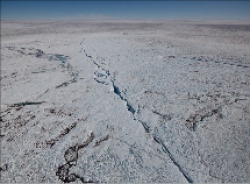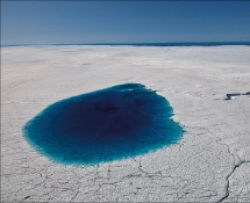Along its western margin, the Greenland Ice Sheet flows seaward at speeds of roughly 100 m/yr. Embedded within the ice sheet are faster flowing (200–15,000 m/yr) outlet glaciers that discharge ice directly to the ocean. Each summer the ice sheet surface melts at rates that can exceed 2.5 m/yr. When glacial mass balance is negative, the excess ice and water lost to the ocean contributes to sea level rise. Recent changes—in particular, increased rates of speed (50–100%) for many large outlet glaciers—have amplified Greenland's contribution to sea-level rise from near zero in the 1990s to a current imbalance of roughly 150 to 250 Gtons/yr (equivalent to 0.4–0.7 mm of sea level rise per year).

A lake bed bisected by an ~3 km long crack through which the lake drained in ~90 minutes.
Glacial motion results from a combination of internal deformation of ice under its own weight, sliding at the ice-bed interface, and deformation of underlying sediments. Basal sliding over a well-lubricated bed is often the source of fast (>100 m/yr) ice motion. Greenland's large coastal melt rates have prompted widespread speculation that a warmer climate will increase melting, which, in turn, will enhance basal lubrication and hasten ice-sheet retreat. Poor knowledge of this process, though, limits quantitative prediction of future ice sheet contribution to sea level rise, as noted by the Intergovernmental Panel on Climate Change.
To address such uncertainties, the NSF Arctic Natural Sciences program and the National Aeronautics and Space Administration jointly funded Ian Joughin of the University of Washington and Sarah Das of the Woods Hole Oceanographic Institution to investigate the role of Greenland's supra-glacial lakes in influencing ice sheet flow.
Joughin and Das initially focused on determining how water can make its way to the base of the ice sheet through ice more than 1 km thick. Several theoretical studies had suggested this could be accomplished through hydro-fracturing. Such fractures were thought to occur when water on the surface penetrates a crevasse or other surface crack. Because water is denser than ice, pressure at the bottom of a water-filled crack is higher than in adjacent ice, so the water effectively acts as a "wedge" driving the crack farther into the ice. If the water level drops as the crack opens, the pressure is relieved, and the crack stops propagating. If, however, the crack stays full, then it should propagate all the way through even the thickest ice. Supra-glacial lakes provide a large reservoir of water that could keep such propagating cracks filled.
While the hydro-fracturing process was well established in theory, it was not clear whether it actually occurred in nature. To investigate this process, Joughin, Das, and their research team instrumented two lakes on the west coast of Greenland with Global Positioning Systems (GPS), seismometers, lake-level loggers, and weather stations. The instruments have been in place since 2006, and, over the three summer seasons thus far, data have been collected during six lake drainages. While it was known from satellite images that large lakes could drain overnight, the data indicated that the lakes could completely drain in 90 minutes or less, with flow into the crack exceeding the rate of flow over Niagara Falls (8,700 m3/s). The GPS also recorded uplift of the ice surface during the drainage events as the water flooded beneath the ice sheet, indicating it made it all the way to the glacial bed.

A supra-glacial melt lake on the Greenland Ice Sheet at ~950 m elevation. The lake is ~1.5 km wide and ~10 m deep.
Although data from the lake sites clearly established that water does reach the bed, this investigation demonstrated that one of the more dire scenarios of run-away ice loss as surface melt lubricates the base of the ice sheet is unlikely to occur. Using a combination of GPS data and satellite images, the researchers showed that summer increases in speed averaging 50–100 m/yr occur over a broad area along the margin of the Greenland Ice Sheet. On the slow moving ice sheet (~100 m/yr), this increase represents almost a doubling in speed. On fast moving glaciers (500 to 15,000 m/yr), which move the bulk of the ice to the ocean, however, the effect of the seasonal increase in speed is small in a relative sense, having little effect on sea level.
Nevertheless, a sudden transition from a frozen to melted bed could have a substantial influence on flow. The base of an ice sheet can either be frozen so that ice must deform over it or melted so that ice can slide over it. A warming climate will likely cause inland migration of the zone where supra-glacial lakes form. If hydro-fracturing at these lakes can breach the thicker ice in the interior regions, where the ice is currently frozen to the bed, the heat delivered by the surface melt could thaw and lubricate the bed over a wide area, potentially destabilizing the ice sheet. Whether this represents a minor or major effect remains uncertain.
For more information, contact Ian Joughin (ian [at] apl.washington.edu) or Sarah Das (sdas [at] whoi.edu).
